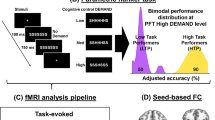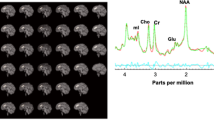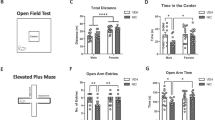Abstract
This is a pilot examination of the hypothesis that some of the effects of smoking cigarettes in humans are mediated through nicotine activation of opioid and dopamine (DA) neurotransmission. Neuroimaging was performed using positron emission tomography and the radiotracers [11C]carfentanil and [11C]raclopride, labeling μ-opioid and DA D2 receptors, respectively. Six healthy male smokers were abstinent overnight. After radiotracer administration, subjects smoked two denicotinized cigarettes, followed 45 min later by two average nicotine cigarettes. Dynamic data were acquired over 90 min, and transformed into parametric maps of receptor availability in vivo (binding potential, BP), corresponding to low and high nicotine smoking periods and analyzed on a voxel-by-voxel basis using SPM'99 and correction for multiple comparisons. Significant activation of μ-opioid receptor-mediated neurotransmission from denicotinized to average nicotine conditions was observed in the right anterior cingulate cortex. DA D2 neurotransmission was activated in the ventral basal ganglia, correlating with Fagerström scale nicotine dependence scores. Lower μ-opioid receptor BP was also detected during the denicotinized smoking condition in the smoker group, compared to baseline scans in non-smokers, in the cingulate cortex, thalamus, ventral basal ganglia, and amygdala. These reductions were reversed during the average nicotine condition in the thalamus, ventral basal ganglia and amygdala. These data point to both the feasibility of simultaneously examining opioid and DA neurotransmission responses to smoking in humans, as well as to the need to examine non-nicotine aspects of smoking to more fully understand the behavioral effects of this drug.
Similar content being viewed by others
Log in or create a free account to read this content
Gain free access to this article, as well as selected content from this journal and more on nature.com
or
References
Aceto MD, Scates SM, Ji Z, Bowman ER (1993). Nicotine's opioid and anti-opioid interactions: proposed role in smoking behavior. Eur J Pharmacol 248: 333–335.
Angulo JA, McEwen BS (1994). Molecular aspects of neuropeptide regulation and function in the corpus striatum and nucleus accumbens. Brain Res Brain Res Rev 19: 1–28.
Benedetti F, Mayberg HS, Wager TD, Stohler CS, Zubieta JK (2005). Neurobiological mechanisms of the placebo effect. J Neurosci 25: 10390–10402.
Berridge KC, Robinson TE (2003). Parsing reward. Trends Neurosci 26: 507–513.
Borras MC, Becerra L, Ploghaus A, Gostic JM, DaSilva A, Gonzalez RG et al (2004). fMRI measurement of CNS responses to naloxone infusion and subsequent mild noxious thermal stimuli in healthy volunteers. J Neurophysiol 91: 2723–2733.
Brody AL, Mandelkern MA, London ED, Childress AR, Lee GS, Bota RG et al (2002). Brain metabolic changes during cigarette craving. Arch Gen Psychiatry 59: 1162–1172.
Carboni E, Bortone L, Giua C, Di Chiara G (2000a). Dissociation of physical abstinence signs from changes in extracellular dopamine in the nucleus accumbens and in the prefrontal cortex of nicotine dependent rats. Drug Alcohol Depend 58: 93–102.
Carboni E, Silvagni A, Rolando MT, Di Chiara G (2000b). Stimulation of in vivo dopamine transmission in the bed nucleus of stria terminalis by reinforcing drugs. J Neurosci 20: RC102.
Davenport KE, Houdi AA, Van Loon GR (1990). Nicotine protects against mu-opioid receptor antagonism by beta-funaltrexamine: evidence for nicotine-induced release of endogenous opioids in brain. Neurosci Lett 113: 40–46.
de la Fuente-Fernandez R, Ruth TJ, Sossi V, Schulzer M, Calne DB, Stoessl AJ (2001). Expectation and dopamine release: mechanism of the placebo effect in Parkinson's disease. Science 293: 1164–1166.
Di Chiara G (2000). Role of dopamine in the behavioural actions of nicotine related to addiction. Eur J Pharmacol 393: 295–314.
Domino EF, Ni L (2002). Clinical phenotyping strategies in selection of tobacco smokers for future genotyping studies. Prog Neuropsychopharmacol Biol Psychiatry 26: 1071–1078.
Eiden LE, Giraud P, Dave JR, Hotchkiss AJ, Affolter HU (1984). Nicotinic receptor stimulation activates enkephalin release and biosynthesis in adrenal chromaffin cells. Nature 312: 661–663.
First M, Spitzer R, Gibbon M, Williams J (1995). Structured Clinical Interview for DSM-IV Axis I Disorders. Biometrics Research Department, New York Psychiatric Institute: New York.
Friston KJ, Worsley KJ, Frackowiak RSJ, Mazziotta JC, Evans AC (1994). Assessing the significance of focal activations using their spatial extent. Hum Brain Mapp 1: 210–220.
Gestreau C, Besson J (2000). Is there tonic activity in the endogenous opioid systems? A c-Fos study in the rat central nervous system after intravenous injection of naloxone or naloxone-methiodide [in process citation]. J Comp Neurol 427: 285–301.
Gorelick DA, Rose J, Jarvik ME (1988). Effect of naloxone on cigarette smoking. J Subst Abuse 1: 153–159.
Heatherton TF, Kozlowski LT, Frecker RC, Fagerstrom KO (1991). The Fagerstrom test for nicotine dependence: a revision of the Fagerstrom tolerance questionnaire. Br J Addict 86: 1119–1127.
Houdi AA, Pierzchala K, Marson L, Palkovits M, Van Loon GR (1991). Nicotine-induced alteration in Tyr-Gly-Gly and Met-enkephalin in discrete brain nuclei reflects altered enkephalin neuron activity. Peptides 12: 161–166.
Hurd YL, Herkenham M (1993). Molecular alterations in the neostriatum of human cocaine addicts. Synapse 13: 357–369.
Jewett DM (2001). A simple synthesis of [11C]carfentanil using an extraction disk instead of HPLC. Nucl Med Biol 28: 733–734.
Karras A, Kane JM (1980). Naloxone reduces cigarette smoking. Life Sci 27: 1541–1545.
Kilts CD, Schweitzer JB, Quinn CK, Gross RE, Faber TL, Muhammad F et al (2001). Neural activity related to drug craving in cocaine addiction. Arch Gen Psychiatry 58: 334–341.
Knutson B, Fong GW, Bennett SM, Adams CM, Hommer D (2003). A region of mesial prefrontal cortex tracks monetarily rewarding outcomes: characterization with rapid event-related fMRI. Neuroimage 18: 263–272.
Koob GF, Le Moal M (2001). Drug addiction, dysregulation of reward, and allostasis. Neuropsychopharmacology 24: 97–129.
Kraus M, Piper J, Kornetsky C (1996). Naloxone alters the local metabolic rate for glucose in discrete bran regions associated with opiate withdrawal. Brain Res 724: 33–40.
Laruelle M (2000). Imaging synaptic neurotransmission with in vivo binding competition techniques: a critical review. J Cereb Blood Flow Metab 20: 423–451.
Logan J, Fowler JS, Volkow ND, Wang GJ, Ding YS, Alexoff DL (1996). Distribution volume ratios without blood sampling from graphical analysis of PET data. J Cereb Blood Flow Metab 16: 834–840.
Malin DH, Lake JR, Carter VA, Cunningham JS, Wilson OB (1993). Naloxone precipitates nicotine abstinence syndrome in the rat. Psychopharmacology (Berl) 112: 339–342.
Minoshima S, Koeppe RA, Mintun MA, Berger KL, Taylor SF, Frey KA et al (1993). Automated detection of the intercommissural line for stereotactic localization of functional brain images. J Nucl Med 34: 322–329.
Moles A, Kieffer BL, D'Amato FR (2004). Deficit in attachment behavior in mice lacking the mu-opioid receptor gene. Science 304: 1983–1986.
Narendran R, Hwang DR, Slifstein M, Talbot PS, Erritzoe D, Huang Y et al (2004). In vivo vulnerability to competition by endogenous dopamine: comparison of the D2 receptor agonist radiotracer (−)-N-[11C]propyl-norapomorphine ([11C]NPA) with the D2 receptor antagonist radiotracer [11C]-raclopride. Synapse 52: 188–208.
Nemeth-Coslett R, Griffiths RR (1986). Naloxone does not affect cigarette smoking. Psychopharmacology (Berl) 89: 261–264.
Nestler EJ (2005). Is there a common molecular pathway for addiction? Nat Neurosci 8: 1445–1449.
Pomerleau OF (1998). Endogenous opioids and smoking: a review of progress and problems. Psychoneuroendocrinology 23: 115–130.
Pruessner JC, Champagne F, Meaney MJ, Dagher A (2004). Dopamine release in response to a psychological stress in humans and its relationship to early life maternal care: a positron emission tomography study using [11C]raclopride. J Neurosci 24: 2825–2831.
Rainville P, Duncan G, Price D, Carrier B, Bushnell M (1997). Pain affect encoded in human anterior cingulate but not somatosensory cortex. Science 277: 968–971.
Schroeder BE, Binzak JM, Kelley AE (2001). A common profile of prefrontal cortical activation following exposure to nicotine- or chocolate-associated contextual cues. Neuroscience 105: 535–545.
Steiner H, Gerfen CR (1998). Role of dynorphin and enkephalin in the regulation of striatal output pathways and behavior. Exp Brain Res 123: 60–76.
Sutherland G, Stapleton JA, Russell MA, Feyerabend C (1995). Naltrexone, smoking behaviour and cigarette withdrawal. Psychopharmacology (Berl) 120: 418–425.
Tanda G, Di Chiara G (1998). A dopamine-mu1 opioid link in the rat ventral tegmentum shared by palatable food (Fonzies) and non-psychostimulant drugs of abuse. Eur J Neurosci 10: 1179–1187.
Unterwald EM (2001). Regulation of opioid receptors by cocaine. Ann N Y Acad Sci 937: 74–92.
Volkow ND, Fowler JS, Wang GJ, Swanson JM (2004). Dopamine in drug abuse and addiction: results from imaging studies and treatment implications. Mol Psychiatry 9: 557–569.
Walters CL, Cleck JN, Kuo YC, Blendy JA (2005). Mu-opioid receptor and CREB activation are required for nicotine reward. Neuron 46: 933–943.
Wewers ME, Dhatt RK, Snively TA, Tejwani GA (1999). The effect of chronic administration of nicotine on antinociception, opioid receptor binding and met-enkelphalin levels in rats. Brain Res 822: 107–113.
Worsley K, Evans A, Marrett S, Neelin P (1992). A three-dimensional statistical analysis for CBF activation studies in human brain. J Cereb Blood Flow Metab 12: 900–918.
Zald DH, Boileau I, El-Dearedy W, Gunn R, McGlone F, Dichter GS et al (2004). Dopamine transmission in the human striatum during monetary reward tasks. J Neurosci 24: 4105–4112.
Zangen A, Nakash R, Yadid G (1999). Serotonin-mediated increases in the extracellular levels of beta-endorphin in the arcuate nucleus and nucleus accumbens: a microdialysis study. J Neurochem 73: 2569–2574.
Zubieta J, Smith Y, Bueller J, Xu Y, Kilbourn M, Meyer C et al (2001). Regional mu opioid receptor regulation of sensory and affective dimensions of pain. Science 293: 311–315.
Zubieta JK, Bueller JA, Jackson LR, Scott DJ, Xu Y, Koeppe RA et al (2005). Placebo effects mediated by endogenous opioid activity on mu-opioid receptors. J Neurosci 25: 7754–7762.
Zubieta JK, Gorelick DA, Stauffer R, Ravert HT, Dannals RF, Frost JJ (1996). Increased mu opioid receptor binding detected by PET in cocaine-dependent men is associated with cocaine craving. Nat Med 2: 1225–1229.
Zubieta JK, Heitzeg MM, Smith YR, Bueller JA, Xu K, Xu Y et al (2003). COMT val158met genotype affects mu-opioid neurotransmitter responses to a pain stressor. Science 299: 1240–1243.
Acknowledgements
This work was supported in part by the Department of Pharmacology Psychopharmacology Research Fund C361024 and by the National Institute of Health Grants R01 DA 016423 and R01 AT 001415 to JKZ. We thank the members of the University of Michigan PET Facility for making this research possible.
Author information
Authors and Affiliations
Corresponding author
Rights and permissions
About this article
Cite this article
Scott, D., Domino, E., Heitzeg, M. et al. Smoking Modulation of μ-Opioid and Dopamine D2 Receptor-Mediated Neurotransmission in Humans. Neuropsychopharmacol 32, 450–457 (2007). https://doi.org/10.1038/sj.npp.1301238
Received:
Revised:
Accepted:
Published:
Issue date:
DOI: https://doi.org/10.1038/sj.npp.1301238
Keywords
This article is cited by
-
Blunted endogenous opioid release following an oral dexamphetamine challenge in abstinent alcohol-dependent individuals
Molecular Psychiatry (2020)
-
Tobacco smoking and dopaminergic function in humans: a meta-analysis of molecular imaging studies
Psychopharmacology (2019)
-
Endogenous opioid system: a promising target for future smoking cessation medications
Psychopharmacology (2017)
-
A gene-by-sex interaction for nicotine reward: evidence from humanized mice and epidemiology
Translational Psychiatry (2016)
-
The dopamine theory of addiction: 40 years of highs and lows
Nature Reviews Neuroscience (2015)



